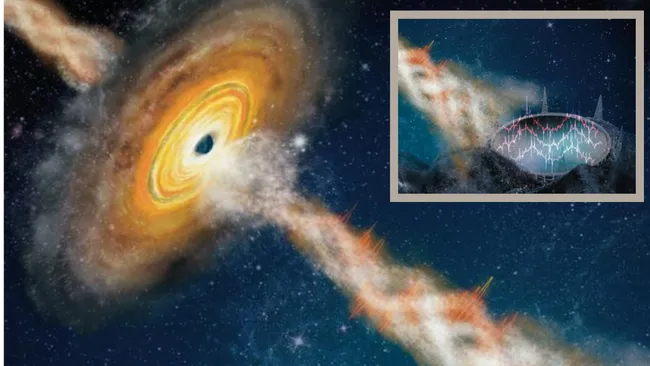Scientists Taken Aback by ‘Unusual’ Radio Signal from Black Hole Jet
Superfast changes to the intensity of a jet blasting out from a small black hole have been detected for the first time.
A group of astronomers have recently observed peculiar alterations in a stream of highly magnetic plasma emitted by a small black hole that is consuming gas and dust. These alterations manifest as periodic fluctuations in the jet, occurring within a fraction of a second, and have been detected by China’s Five-hundred-meter Aperture Spherical radio Telescope (FAST).
The astronomers are aware that this enigmatic blinking entity, known as GRS 1915+105, comprises of a regular star orbiting a stellar black hole – a black hole formed from the remnants of a massive star. As the star orbits the black hole, some of its material is drawn towards the cosmic behemoth. However, the black hole fails to consume all of the material and instead propels a portion of it into the jet, which appears to emanate from its poles.
The research team speculates that the observed fluctuations in the jet’s energy may be attributed to the misalignment between the black hole’s rotation and its accretion disk – the disk of matter orbiting around it that it feeds on. This misalignment could potentially cause the jet to oscillate, resembling the motion of a spinning top in the cosmos. Consequently, when the jet deviates from its usual direction, its energy diminishes. However, within a fraction of a second, the system rotates back to its original position, and the jet’s energy returns to normal.
According to Wei Wang, a professor of astrophysics at Wuhan University in China and the lead author of the research, the peculiar signal has a rough period of 0.2 seconds, which is equivalent to a frequency of about 5 Hertz. This signal is not always present and only appears under specific physical conditions. Fortunately, our team was able to detect the signal twice, once in January 2021 and again in June 2022.
GRS 1915+105 is referred to as a microquasar by researchers, which is a smaller version of a quasar found on a stellar scale. Quasars are incredibly bright galactic centers that contain supermassive black holes, many times larger than the sun.

These cosmic giants exert their immense gravitational force to attract surrounding matter. Some of this matter falls beyond the black hole’s event horizon, the point of no return where even light cannot escape. However, certain material manages to escape this fate and is directed towards the black hole’s poles, emitting super-energetic jets into space. This phenomenon also occurs in microquasars, albeit on a much smaller scale.
The changes observed in GRS 1915+105, known as quasi-periodic oscillations (QPO), have never been observed in radio waves emitted by a black hole of this kind before. QPOs provide valuable insights into the physics of black holes and their surrounding systems. Therefore, studying this changing microquasar, located approximately 28,000 light-years away from Earth in the constellation Aquila, could provide valuable information about the feeding behavior of smaller black holes.
The QPO observed in radio waves could potentially be the first evidence of changes in these types of jets. However, the exact cause of these oscillations remains a mystery.
According to Bing Zhang, an astronomer at the University of Nevada and co-author of the study, X-rays are typically used to study the accretion disk surrounding a black hole, while radio emissions are used to study the jet that is launched from the disk and the black hole. The exact mechanism that causes temporal modulation in a relativistic jet is still unknown, but one possibility is that the jet undergoes precession, meaning that its direction regularly changes and then returns to its original direction every 0.2 seconds.
This phenomenon could be caused by a misalignment between the spin axis of the black hole and the disk of hot gas and dust surrounding it. This misalignment occurs because as the black hole spins, it drags spacetime along with it, a phenomenon known as frame-dragging or the Lense-Thirring effect.
Zhang also mentioned that there are other possibilities to consider, and further observations of galactic microquasars like this one will provide more clues to understanding these mysterious signals known as QPOs (quasi-periodic oscillations).
The research conducted by the team was published in the July 26 issue of the journal Nature.
This article is republished from space.com under a Creative Commons license. Read the original article.



0 Comments